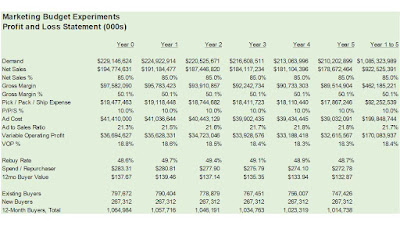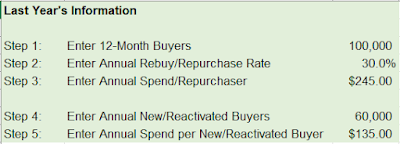When I have a new product offering, I share it with you, the loyal reader, at a significant discount. You help me test out a pilot product, you save money.
In recent months, my Marketing Budget Experiments projects lead clients to a common question ... "how do I increase customer loyalty?" With new customers becoming harder to acquire and more expensive to generate, some are electing to swing back towards loyalty/retention. In my project work, there are key Inflection Points where your brand can facilitate increased loyalty. There are obvious ones like Christmas, or Spring if you are the gardening world. There are profitable ones, like opening a proprietary credit account.
Your brand possesses key inflection points - and my new Loyalty / Inflection Points pilot project is designed to help you find them, score your customer base, and then act upon what you learn.
Read here for more details.
Customer Loyalty: Inflection Points
Kevin
Hillstrom: President, MineThatData
September
13, 2023
Inflection Points >
Points
In my Loyalty projects, there are inflection
points in the trajectory of the customer that matter. When the customer purchases
as a result of reaching an inflection point, the customer becomes more loyal.
The marketers I work with view this almost from
the opposite point of view. They create programs that offer points, thinking
that customers are motivated by points to the point of spending more to earn
more points faster so that the customer can earn a discount. This process
rearranges the transfer of profit from the customer to the brand. The brand (in
theory) holds more profit in the short-term, giving up profit longer-term in
exchange for a customer that (in theory) is more loyal. Would the customer have
become more loyal without the loyalty program? Few can answer that question,
and that’s the problem when brands view Points > Inflection Points.
What Are Inflection Points?
Inflection Points are situations where
customers transition from being less-valuable to more-valuable. Every brand has
situations where the customer makes a decision that significantly alters future
profitability.
Inflection Point: When a customer purchases for the first time,
there is a small window where the customer is likely to purchase again. This
window is typically open for 3-12 weeks. The customer expects the first
purchase experience to be good (not perfect), and the customer sometimes looks
to “complement” the first purchase with additional merchandise. If you want
loyal customers, you have to assist the customer as the customer goes through
this critical inflection point. This situation is not solved by “earning
points”. This situation is solved by paying attention to the customer. Are you
a B2B marketer? Yes? Did you reach out to all first-time buyers who spent more
than $500 on a first order to make sure that the order was executed perfectly,
and if not executed perfectly, did you remedy the situation? Are you a B2C
marketer? Yes? Did you analyze your visitation data to see if the customer is
looking to complement the first order with additional merchandise, and if the
answer is “yes” did you do something to encourage the customer to purchase for
a second time? These are all important components of a loyalty program. You
cannot have a loyal customer unless you convert a first-time buyer to a second
purchase. Inflection Points > Points.
Inflection Point: Anniversary events are very important. Say
you sell products that help an organization run an annual conference. For each
of the past two years, the customer spent $12,000 with your brand in July. What
are you doing with this specific customer this June/July? Are you a B2C brand?
You have a significant minority of your customer base who only purchases in
November/December. How much money do you spend trying to convert the customer
to a purchase in January-October? How much money do you spend trying to convert
the customer to a purchaser prior to the Anniversary (Christmas) Inflection
Point? Should you spend money on a purchase that will likely happen anyway?
Should you spend money trying to force the customer to do something the
customer does not want to do? There aren’t easy answers to those questions.
There are, however, Inflection Points that need to be addressed. Learn what
your Inflection Points are, and have a strategy in place to address customers
who are about to enter a key Inflection Point.
Inflection Point: At some point, your
customer changes behavior. If you work at Starbucks, you notice that Heather is
buying a drink every single morning, Monday – Friday. That’s an Inflection
Point. Heather is transitioning to a full-on addiction. Your job changes as
well – you harvest profit from her addiction by making her purchase experience
as easy as possible. She’s going to purchase every morning, so 20% off doesn’t
make any sense. Points “might” make sense if you are leading Heather toward
something she aspires to. If you work in B2B, the customer who previously spend
$250 a year spends $1,400. That’s an Inflection Point. The customer trusts you
more, and as a consequence you need to work harder to keep that trust. Many
marketers wait for an Inflection Point like “The Customer Just Spent
$2,500 in Total, The Customer is Now Loyal and Eligible for Points”.
View this in an opposite manner. Think this way … “The Customer Just
Reached An Inflection Point and is About to Become Loyal so Let’s Close the
Deal”.
When I worked at Nordstrom (2001-2007), we held
our Anniversary Sale every year in late July – early August. Our merchandise
was offered at 20% off – new Fall products. Customers went bonkers over this
sale – we only had five sales per year so 20% off was meaningful. However, we
allowed “special” customers to have early access to our merchandise. They could
“preview” the assortment a week prior to the sale, going “behind closed doors”
to see the product. They could pick out whatever they wanted. We’d hold the
products for them, and on the first day of the sale the customer could walk
into the store, pass the feeding frenzy, and walk out with his/her merchandise,
showing off to the customer that s/he was “special”.
If a customer spent $700 in the year prior (I
believe it was $500 if the customer was a Nordstrom Credit customer), the
customer earned this “pre-sale” experience. We sent period messages to the
customer, telling the customer how close the customer was to earning this
“status”. Our deadline, if I remember correctly, was June 1 to earn “pre-sale”
rights. We’d send messaging to the customer leading up to June 1. No points. No
other incentive. Just spend $700 to earn the right to buy merchandise one week
early … no discount/promotion on top of the sale price every other customer
paid.
On an annual basis, we learned (via control
groups) that our customer base spent $100,000,000 more per year (generating
more than $25,000,000 per year in incremental profit) … splitting dollars
during Anniversary Sale and in the months leading up to the sale to hit a $700
spending level. Inflection Points were critically important … Anniversary Sale
was a key Inflection Point … communication in April/May telling the customer
that the deadline to spend $700 was fast approaching was another key Inflection
Point.
Also – we knew that our better customers
purchase about six times per year … $700 of annual spend translated to about
six purchases per year. The $700 Inflection Point (which triggered special
status during the Anniversary Sale) matched the point where we knew that
Customer Lifetime Value surged.
You have similar dynamics in your business.
Learn how your customers interact with your Events. Do any Inflection Points
interact with key Events? If the answer is “yes”, you too can create a
Nordstrom-like loyalty experience.
Inflection Point: Each business has an
Inflection Point where the customer has a 60% chance of purchasing again in the
next year. This is the point where “loyal behavior” happens. For many of my
clients, this happens after a fifth purchase. Carefully analyze when your customers
achieve a 60% chance of buying again in the next year. If you want to pursue a
traditional loyalty program, this is the audience you want to focus on. If your
annual repurchase rate is under 35%, do not expect to identify a large audience
with a 60% or greater chance of repurchasing in the next year. Your job changes
– you shift your focus from Loyalty to Inflection Points.
Inflection Points and Loyalty: An Analysis
For my long-term client base and readership
audience, I preview new products at a reduced price. In this case, I am
previewing my “Inflection Points” analysis at the reduced price of $12,000.
Long-term clients and my readers get an
opportunity to help shape what a future Inflection Points analysis looks like
at a significant discount. I will analyze your customer base, identifying the
Inflection Points that can be acted upon to create a more loyal customer base.
I will analyze purchase transitions … first to second, second to third etc. to
learn what Inflection Points exist. I will tell you when a customer becomes
“loyal” (i.e. annual repurchase rate is 60% or greater). I will identify any Anniversary
Events (i.e. customer purchases every November/December or buys seeds every
March). I will thoroughly describe the process the customer takes as the
customer goes from a first purchase to a loyal buyer.
Some elements of this analysis are similar to
the Customer Development work I performed back in 2021.
The outcome of this project are “Loyalty
Scores” … a model that describes the stage the customer belongs to on the
trajectory from first purchase to loyalty to inactive customer. You will learn,
for every customer, where the customer is on that journey.
·
Loyal
Buyer.
·
Inflection
Buyer (just crossed an inflection point).
·
Active
Buyer.
·
Anniversary
Buyer (about to approach an Anniversary Event – take action!).
·
Lapsed
Buyer.
·
Abandoned
Buyer (i.e. no longer likely to purchase again).
If there are other segments that need to be
included, I will include them.
I will provide pseudo-code that allows you to
score your own file on a weekly basis, so you can act upon what is learned from
this project. You should be able to identify an “Inflection Buyer” and take
action as soon as the “Inflection Activity” happens.
















